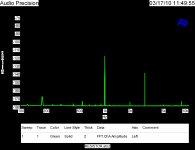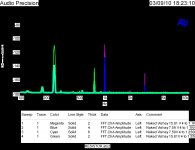I ordered a bunch of 1/2 watt metal film vishay resistors, and assumed they would be the size of carbon. When I got them, I assumed someone filled the order wrong and gave me 1/8 watt resistors..they are soooo tiny. They are about 2.5 mm diameter, and 4 or 5 mm long. I verified that they are indeed 1/2 watt resistors. I do not want to use them.
What do you guys use for standard 1/2 watt signal resistorss?
What do you guys use for standard 1/2 watt signal resistorss?
I guess I will use them..I already have them. It is just that they are so tiny. I guess I am old school..used to seeing a 1/2 watt resistor being about 1/8 inch in diameter and about a 1/2 inch long. These things are seriously about the size of a grain of rice. The short grain variety
I guess I will use them..I already have them. It is just that they are so tiny. I guess I am old school..used to seeing a 1/2 watt resistor being about 1/8 inch in diameter and about a 1/2 inch long. These things are seriously about the size of a grain of rice. The short grain variety
Hey, Mark--I can understand you not wanting to use those little, tiny resistors. In fact, if you just want to mail them to me, I'll dispose of them for you!
isn't cooling in resistors a function of size ? Unless these Vishays are made of some exotic material with extremely high thermal emissivity, it seems reasonable to assume that they will run at a much higher temperature than a conventionally sized 1/2W resistor ?
(and that is a bad thing. right ?)
(and that is a bad thing. right ?)
What do you guys use for standard 1/2 watt signal resistorss?
The resistive kind.
Magura
Usually the power rating for modern metal film (MF) resistors is the power dissipation for when the resistor reaches 75°C. That is to say that when a resistor rated 1/2W dissipates that 1/2W, it will have a temperature of 75°C (50°C rise from 25°C ambient iirc).
I don't know if that applies to carbon comp (CC) resistors too, but I hope not since their temp coeff is much much higher than compared to a MF (or any other type). But still, if a resistor in a certain spot will dissipate a considerable amount of power the accompanied temperature rise sometimes has to be taken into account. To avoid that scenario one can pick a higher wattage type, with the additional convenience that higher power types usually are less noisy (due to higher track width => less fringe effects with spiral-cut resistive elements).
To answer your question...I use 1% Vishay MRS25 MF resistors for just about anything, and Vishay/Dale RN55D, RN60D or RN65D for when I get picky. I like Welwyn RC55Y when a precision resistor is needed, f.e. in feedback networks.
I don't know if that applies to carbon comp (CC) resistors too, but I hope not since their temp coeff is much much higher than compared to a MF (or any other type). But still, if a resistor in a certain spot will dissipate a considerable amount of power the accompanied temperature rise sometimes has to be taken into account. To avoid that scenario one can pick a higher wattage type, with the additional convenience that higher power types usually are less noisy (due to higher track width => less fringe effects with spiral-cut resistive elements).
To answer your question...I use 1% Vishay MRS25 MF resistors for just about anything, and Vishay/Dale RN55D, RN60D or RN65D for when I get picky. I like Welwyn RC55Y when a precision resistor is needed, f.e. in feedback networks.
Last edited:
isn't cooling in resistors a function of size ? Unless these Vishays are made of some exotic material with extremely high thermal emissivity, it seems reasonable to assume that they will run at a much higher temperature than a conventionally sized 1/2W resistor ?
(and that is a bad thing. right ?)
That is what I was thinking...I would think there would be wide swings in temperature fluctuation.
Here is the link: check them out:
Digi-Key - PPC1.00KXCT-ND (Manufacturer - SFR16S0001001FR500)
This is the distortion produced by these resistors in my tests as shown in Linear Audio Vol. 1. The 0 db reading is at 1/16 watt. The 1k tone is suppressed by the measurement method. There is very little 2nd harmonic distortion and more 3rd. The third drops by 6 db for every halving of power. It increases by 3 db for every having of test frequency. DC will increase the even order harmonic distortion. Excess noise is shown in the spreading of the base at the 1K test frequency.
So the results you get will depend on the voltage across the resistor.
So the results you get will depend on the voltage across the resistor.
Attachments
isn't cooling in resistors a function of size ? Unless these Vishays are made of some exotic material with extremely high thermal emissivity, it seems reasonable to assume that they will run at a much higher temperature than a conventionally sized 1/2W resistor ?
(and that is a bad thing. right ?)
The exotic part is not that they will dissipate the heat any better. There is very little variation in how different resistors will dissipate heat. The exotic part is that the material can withstand super high temperatures and still meet the specs. In the datasheet you linked, they will be at 85 C at 1/2 watt -- close to boiling water! I can pretty much guarantee that this will discolor even the best PCB materials and start the cheap ones on fire...
They said that hot spots of up to 155 C were permissible! This is probably the areas with the worst air circulation, like where the resistor touches the PCB...
Vishay produces many grades and types of resistors. Those that you have are their standard grade.
Vishay started off life as a specialty company that ONLY built better-than-MIL spec parts. I guess they made a lot of money selling $10 resistors, because now they have bought several dozen major component manufacturers, first passives, then actives.
The resistors shown are actually below standard grade. They have some of the worst specs I have ever seen from a metal film resistor. But they are probably cheap enough.
This is the distortion produced by these resistors in my tests as shown in Linear Audio Vol. 1. The 0 db reading is at 1/16 watt. The 1k tone is suppressed by the measurement method. There is very little 2nd harmonic distortion and more 3rd. The third drops by 6 db for every halving of power. It increases by 3 db for every having of test frequency. DC will increase the even order harmonic distortion. Excess noise is shown in the spreading of the base at the 1K test frequency.
So the results you get will depend on the voltage across the resistor.
I believe that most of this distortion is caused by heating of the resistor interacting with the non-zero tempco of the part. These parts had a tempco of 250 ppm, while the very best Vishay parts ($8 each) are only 2 ppm.
It used to be that Vishay only made bulk-metal resistors. Now they (through their many divisions) make almost any kind of resistor except carbon composition.
surplus resistors
Maybe twenty years ago I found a surplus store in Silicon Valley which had grey Corning RN60D's for $0.08 a piece. I bought a handfull of each of the more common values, and these have served me well over the years in various projects.
Now I buy PRP from Michael Percy and Parts Connexion. I like these better than the old Cornings and Resistas I used to get. I would rate them equal to the original (copper) Holco H4, which are going away (as will the new ferrous ones, I predict - yechh ).
).
In the Pass B1 I'm working on, I'm using Holco & PRP's for all the signal resistors, except for the 1 Megs, which are Corning greys that I still have.
Hope my ramblings interest someone here...
-Chas
Maybe twenty years ago I found a surplus store in Silicon Valley which had grey Corning RN60D's for $0.08 a piece. I bought a handfull of each of the more common values, and these have served me well over the years in various projects.
Now I buy PRP from Michael Percy and Parts Connexion. I like these better than the old Cornings and Resistas I used to get. I would rate them equal to the original (copper) Holco H4, which are going away (as will the new ferrous ones, I predict - yechh
 ).
).In the Pass B1 I'm working on, I'm using Holco & PRP's for all the signal resistors, except for the 1 Megs, which are Corning greys that I still have.
Hope my ramblings interest someone here...
-Chas
I believe that most of this distortion is caused by heating of the resistor interacting with the non-zero tempco of the part. These parts had a tempco of 250 ppm, while the very best Vishay parts ($8 each) are only 2 ppm.
The third harmonic on these resistors certainly is a thermal issue. What is interesting is the 9th harmonic also shows up! One of the few resistors that show that high a harmonic!
Most of the resistors measured had third harmonic that seem to related to the tempco, a few did not. The notable cheapie had virtually nothing but third so used at low power should be a low cost cheat.
The other test I am playing with is thermo-electric. When you heat one lead some resistors generate a voltage. With a quick soldering iron tip on one end that can go as high as several millivolts.
Charles,
Also note on the bulk metal tests the thermal issues track as expected but are higher than they should be if it were tempco alone.
ES
Last edited:
Heat transfer is probably proportional to surface area, so the small ones heat up a lot more for the same power burnt but
More thermal mass, more thermal transfer: these will reduce this distortion. So add a 20 cent heat sink to a 20 cent resistor and save $7.60 per resistor!
- Status
- This old topic is closed. If you want to reopen this topic, contact a moderator using the "Report Post" button.
- Home
- Amplifiers
- Pass Labs
- What kind of resistor do you use?

